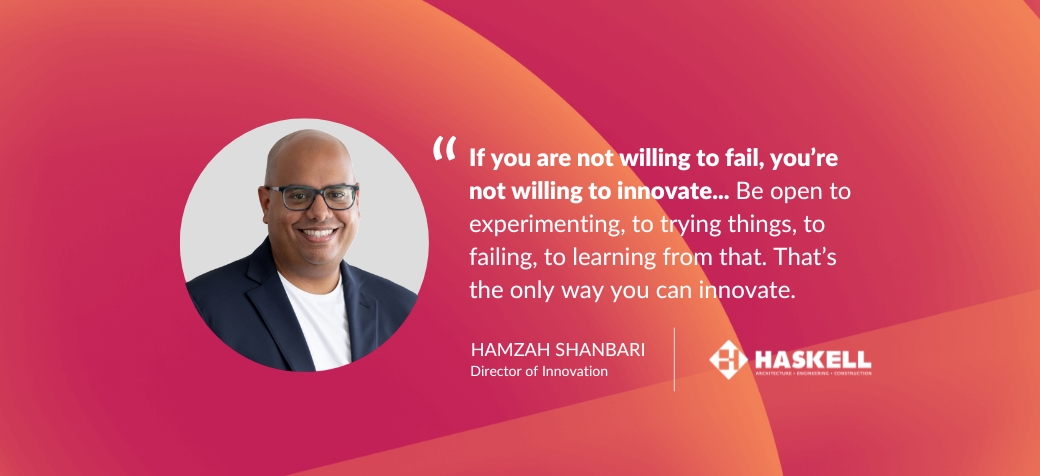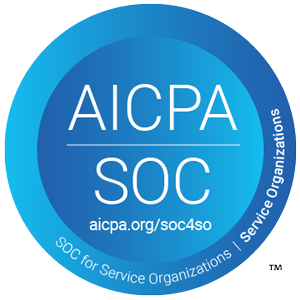Pushing the envelope is easier with AI and robotics on your side.
Innovation no longer needs to be a slow, incremental process. As all industries undergo rapid AI-driven transformations, we’re seeing massive shifts in how teams collaborate, communicate, and execute projects. Construction is no different.
For industry leaders like Hamzah Shanbari, Director of Innovation at Haskell, AI is an essential tool in optimizing construction workflows and ensuring that all stakeholders operate with the most up-to-date information. We sat down with Shanbari to discuss how to build a culture of innovation, run high-impact events like the Big Pitch, AI’s growing role in innovation technology, and his book, Paperless Builders: The Why, What, and How of Construction Technology.
Watch the full interview below, or read on for a curated selection of key takeaways.
Key takeaways
- Assign a dedicated team to own and implement winning ideas, rather than relying on idea submitters to carry them forward.
- Adopt a mindset of experimentation and be open to failure — this is essential to unlocking AI’s full potential and driving real innovation.
- Treat innovation events like cultural moments that bring cross-functional teams together and elevate idea contributors in front of leadership.
- Use AI-powered simulations early in the design process to predict risks, validate feasibility, and optimize outcomes before construction begins.
- Leverage AI and robotics to augment human labor, improve safety, and attract the next generation of talent to the construction industry.
Don’t Hand Off Ideas—Own Them
Many organizations struggle to turn hackathons or pitch ideas into real-world outcomes. Survey data tells us that only 29% of projects move beyond the event and are implemented. Therefore, the problem lies in follow-through. Hamzah points out a common pitfall: companies assume that the person who submitted the idea should also lead its execution. But innovators already have day jobs, and without structured support, ideas stall.
“That statistic is sad. A lot of companies try to give ownership to the outcome of a hackathon or event to the people who submitted the idea. And I think that’s where they mostly die — because those people have full-time jobs. What we did differently is that we, as the innovation team, even though we’re still small and nimble, take full responsibility for running the entire project. Yes, the idea owners are 100% involved as their time permits — they attend meetings, give feedback, and help shape it — but we’re the ones seeing it through to deployment.”
At Haskell, the innovation team doesn’t just facilitate the pitch event — they actively develop and implement the winning ideas. The original submitters stay involved as advisors and champions, but the heavy lifting belongs to the team that has the tools, time, and mandate to bring ideas to life. It’s a model that ensures momentum doesn’t end when the event does.
Execution matters just as much as ideation. That’s why we developed Hackathon 5: To help you turn employee ideas into implemented outcomes, faster and more reliably than ever before. Read our launch announcement to learn more.
Embracing Change Is the First Step Toward Innovation
Despite AI’s immense potential, many organizations struggle with adoption. The biggest challenge isn’t the technology itself, it’s the mindset shift required to embrace change. Many leaders are hesitant to implement new tools that could disrupt long-standing processes, especially in the construction industry. However, as Shanbari emphasizes, failing to adapt means failing to innovate. Without an open mindset, businesses cannot harness the full potential of AI to drive progress.
“I start the book with chapter one: Change Is Hard. Literally, chapter one, because if you can’t overcome that hurdle, everything else in the book is going to be irrelevant to you. Change is hard because it’s the fear of the unknown. It’s the fear of what else is on the other side of this technology implementation… I’m preaching that it’s okay to not know. It’s okay to experiment. It’s okay to fail and learn from that and do it again. And without overcoming that hurdle at the beginning, before you even embark on anything that has to do with innovation and technology, if you are not willing to fail, you are not willing to innovate.”
Shanbari’s perspective underscores a crucial point: Experimentation is key. AI thrives in environments where leaders and teams are willing to iterate, take calculated risks, and use failure as a learning tool. Those who hesitate to integrate AI into their operations risk falling behind competitors who embrace these rapid advancements.
Create a Cultural Moment, Not Just an Event
For Haskell, the Big Pitch isn’t just a pitch competition, it’s a cultural event. By bringing together leaders and employees from across business units, the event fosters connection, visibility, and momentum. It’s a space where everyone in the room shares the same goal: surfacing something innovative that could shape the future of the company. This sense of collective purpose has proven to be just as valuable as the ideas themselves.
“What I love about Big Pitch is it really gets a lot of people in the same room with one common goal — something different is going to come out of this. That’s what excites me the most. We’ve got BU leaders, vice presidents, even presidents in the audience. Not necessarily judging or participating, but showing up to support the people who are brave enough to bring their ideas forward and pitch to an executive panel. That visibility and energy is what makes the Big Pitch so unique for us.”
This format not only boosts engagement but reinforces the message that innovation is a shared responsibility. From executives to first-time contributors, everyone plays a role in making the event, and the ideas it generates, a success. That kind of shared ownership can’t be replicated in a suggestion box or one-off R&D meeting.
AI-Powered Simulation Is the New Future
As AI continues to evolve, its capabilities extend far beyond design. Simulation technology is transforming how projects are assessed before they even break ground. By using AI-driven simulations, teams can test the feasibility, safety, and community impact of projects, minimizing unforeseen issues and optimizing outcomes before construction even begins.
“There’s going to be a whole kind of mandatory step between design and construction. We can start as early as conceptual design, which is that simulation aspect. With all these advances in technology and AI, we can simulate. We can say, here’s the design: Is it constructible in the time frame and the budget that you’re setting for this? Is it safe for the employees or workers to be on that job site? What other impacts is it going to have on the local community? So there are so many different things that you can be simulating before you even step foot on the job site and start deploying people. I think that’s going to be a fundamental change.”
With AI-driven simulations, companies can anticipate obstacles long before they occur, leading to more efficient and cost-effective project execution. This predictive capability ensures that businesses are making decisions backed by data, rather than relying on intuition or outdated processes.
Robots Aren’t Our Enemy
A common concern surrounding AI is the fear that automation and robotics will replace human workers. However, Shanbari asserts that these advancements are designed to complement human labor, making jobs safer, more efficient, and ultimately more rewarding. Not only that, but the inclusion of advanced technology may help draw a younger audience to the field, a demographic that Shanbari believes is missing from construction.
“People kind of get wary [that] robots are coming for our jobs. No, they’re coming to augment your job, to make it easier, safer, more efficient, you know, and help us with the great labor shortage that we are dealing with as an industry, because it’s not attractive enough as an industry for the young generation to get into. Hopefully, with all this technology, robotics, AI, and different developments, we can start attracting more and more of the new generation in different fields that we don’t incorporate in the construction industry right now.”
Rather than eliminating jobs, AI-driven automation is filling critical gaps in industries struggling with workforce shortages. By taking on repetitive or hazardous tasks, robots allow skilled workers to focus on higher-value aspects of their roles, ultimately driving greater productivity and job satisfaction.
AI As a Catalyst for Change
AI is no longer a distant concept. It is actively transforming industries by enhancing communication, optimizing design, and streamlining operations. Leaders who embrace AI-driven tools will find themselves at the forefront of their fields, able to iterate faster, solve complex challenges, and execute projects with unprecedented efficiency. As Shanbari’s insights demonstrate, AI is not just a tool; it’s a game-changer.
Brightidea helps organizations turn ideas into impact. Schedule a Hackathon 5 demo today to see how we can help revolutionize your next event at Brightidea.com.


